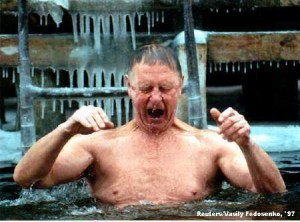We’ve got three useful articles to point out. One deals with recovery strategies for runners, specifically why damage is a good thing. (I imagine this information will apply to other types of athletes–cyclists, swimmers, weightlifters/bodybuilders for instance). Another article discusses research into how training in the heat can increase cycling performance in both hot and cool conditions. Finally, research suggests a healthy lifestyle can affect cardiovascular health more than genetics.
When Damage Is A Good Thing
Steve Magness is a Washington, D.C. area runner and exercise scientist who writes a blog called the Science of Running. Recently he’s written a piece for Running Times called When Damage is a Good Thing. Magness does a good job of explaining the training adaptation cycle:
“We improve from training by putting our body through stress that it normally does not encounter. When the body encounters these stressors, whether it is a decrease in oxygen, increase in lactate or low glycogen stores, it responds by increasing our ability to deal with the stressors, thereby improving our running performance. The stress, recover and adapt cycle is the foundation of training.”
Most important to the article though is the discussion of how recovery methods such as anti-inflammatories, ice baths, and antioxidants may impede the adaptations we’re looking for. Magness states:
“All of this scientific theory and research sounds good, but what does it mean practically? It doesn’t mean that antioxidants, ice baths, Advil or taking a Gatorade while running is necessarily bad. It means using those items at the wrong time or after the wrong workout could negate some of those hard-earned training adaptations. The key is to understand when it’s beneficial to use those methods and when to avoid them.”
Read the whole article to understand the strategy Magness recommends. It’s certainly an issue worth pondering if you’re a serious athlete–endurance athlete or otherwise.
Heat Conditioning for Cyclists
Science Daily gives us an article titled Exercising in the Heat May Improve Athletic Performance in Cool and Hot Conditions. Researchers at the University of Oregon studied two groups of cyclists: one group underwent heat acclimation while training and the other group worked out in a cool environment. What did the researchers learn?
The study found performance increases of approximately 7 percent after 10 heat acclimation exposures. “In terms of competitive cycling, 7 percent is a really big increase and could mean that cyclists could use this approach to improve their performance in cooler weather conditions,” said researcher Santiago Lorenzo.
Healthy Lifestyle Wins Out Over Genetics
The final article, Healthy Lifestyle Has Bigger Impact on Cardiovascular Health Than Genetics, also comes from Science Daily. There are two big points from this article which discusses two studies.
- To stay healthy in older age, five key healthy behaviors should be adopted while young. Those behaviors are: not smoking, low or no alcohol intake, weight control, physical activity and a healthy diet.
- One of the studies states, “only a small proportion of cardiovascular health is passed from parent to child; instead, it appears that the majority of cardiovascular health is due to lifestyle and healthy behaviors.” Thus we see that poor genetics is sort of a straw man when it comes to determining our health. It’s our own behavior that’s far more important.


